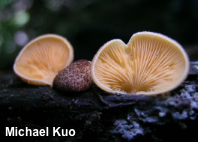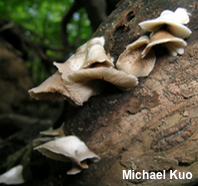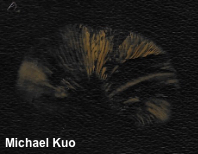| Major Groups > Gilled Mushrooms > Dark-Spored > Pleurotoid Mushrooms > Crepidotus |

|
[ Basidiomycota > Agaricales > Inocybaceae . . . ] The Genus Crepidotus by Michael Kuo, 8 August 2023 This genus of small, brown-spored pleurotoid mushrooms contains a multitude of boring whitish to brownish species and a few (well, two) that are more interesting. The rare Crepidotus cinnabarinus is bright red, and the very common Crepidotus crocophyllus usually features yellow to orange gills . . . but pretty much everything else is brown or white, and requires extensive microscopic study for confident identification. If this sounds like fun to you, I invite you to explore the wonderful world of Crepidotology. Alternatively, you can call your collection a "run-down elevator" (a de-crepit Otis) and have done with it. If you are bound and determined, microscopic features used to separate species in Crepidotus include the anatomy of spores, cheilocystidia, and pileipellis, as well as determining the presence or absence of clamp connections. Hesler & Smith's 1965 monograph of the genus in North America is one starting place for identification work, but Mexican researchers Victor Bandala and Leticia Montoya have made substantial contributions to North American Crepidotus research in a series of publications (2000a, 2000b, 2008a, 2008b)–and they have simplified the picture somewhat by widening species concepts and allowing for more variability in features. Another starting point is Senn-Irlet's 1995 treatment of the genus in Europe, or her more recent treatment (2018), which covers northern Europe. Bear in mind, however, that none of these works is supported by contemporary, DNA-based study, so your efforts may wind up being Quixotic once the DNA windmill is erected by more current research. |
|
|
Key to 8 Crepidotus Species in North America
References Aime, M. C. (2001). Biosystematic studies in Crepidotus and the Crepidotaceae. Doctoral dissertation, Virginia Polytechnic and State University. Aime, M. C. & J. Ball (2002). The mating system in two species of Crepidotus. Mycotaxon 81: 191–194. Aime. M. C., R. Vilgalys & O. K. Miller (2005). The Crepidotaceae (Basidiomycota, Agaricales): Phylogeny and taxonomy of the genera and revision of the family based on molecular evidence. American Journal of Botany 92: 74–82. Aime, M. C., J. Vila & P. -A. Moreau (2009). Crepidotus subfulviceps comb. nov., a stipitate Crepidotus from temperate North America and Europe. Mycotaxon 110: 283–287. Bandala, V. M. & L. Montoya (2000a). A revision of some Crepidotus species related to Mexican taxa. Mycological Research 104: 495–506. Bandala, V. M. & Montova, L. (2000b). A taxonomic revision of some American Crepidotus. Mycologia 92: 341–353. Bandala, V. M. & L. Montoya (2004). Crepidotus from Mexico: New records and type studies. Mycotaxon 89: 1–30. Bandala, V. M., L. Montoya & E. Horak (2006). Crepidotus rubrovinosus sp. nov. and Crepidotus septicoides, found in the cloud forest of eastern Mexico, with notes on Crepidotus fusisporus var. longycystis. Mycologia 98: 131–140. Bandala, V. M. & L. Montoya (2008a). Type studies in the genus Crepidotus. Mycotaxon 103: 235–254. Bandala, V. M., L. Montoya & M. Mata (2008b). Crepidotus crocophyllus found in Costa Rica and Mexico and revision of related species in subsection Fulvifibrillosi. Mycologia 100: 335–346. Bandala, V. M., L. Montoya & M. Mata (2008c). New species and records of Crepidotus from Costa Rica and Mexico. Fungal Diversity 32: 9–29 Gonou-Zagou, Z. & P. Delivorias (2005). Studies on Basidiomycetes in Greece 1: The genus Crepidotus. Mycotaxon 94: 15–42. Hesler, L. R. & Smith, A. H. (1965). North American species of Crepidotus. New York: Hafner. 187 pp. Jančovičová, S., M. Tomšovsky, A. Urban & I. Krisai-Greilhuber (2014). New records of Crepidotus malachioides (Crepidotaceae, Agaricales). Sydowia 66: 79–97. Jančovičová, S., S. Adamčík, B. P. Looney, M. Cabon, M. Čaplovičová, M. Kopáni, S. R. Pennycook & K. Adamčiková (2017). Delimitation of European Crepidotus stenocysitis as different from the North American species C. brunnescens (Crepidotaceae, Agaricales). Phytotaxa 328: 127–139. Jančovičová, S., K. Adamčiková, M. Cabon & S. Adamčík (2020). How variable is Crepidotus variabilis? Phytotaxa 449: 243–264. Jančovičová, S., K. Adamčiková, M. Cabon & S. Adamčík (2022). Phylogeny of Crepidotus applanatus look-alikes reveals a convergent morphology evolution and a new species C. pini. Journal of Fungi 8: 489. Kasuya, T., K. Uno & K. Hosaka (2014). Reexamination of Crepidotus crocophyllus (Basidiomycota, Fungi) in Japan, with reference to its phylogenetic placement. University Bulletin of the Chiba Institute of Science 7: 159–166. Krisai-Greilhuber, I., B. Senn-Irlet & H. Voglmayr (2002). Notes on Crepidotus from Mexico and the south-eastern USA. Persoonia 17: 515–539. Luther, B. S. & Redhead, S. A. (1981). Crepidotus cinnabarinus in North America. Mycotaxon 12: 417–430. Ripková, S., M. C. Aime & P. Lizon (2005). Crepidotus crocophyllus includes C. nephrodes. Mycotaxon 91: 397–403. Ripková, S. & S. Gledura (2010). Crepidotus ehrendorferi in Slovakia and taxonomic notes on related species. Czech Mycology 61: 175–185. Senn-Irlet, B. (1995). The genus Crepidotus (Fr.) Staude in Europe. Persoonia 16: 1–80. Senn-Irlet, B. & A. A. R. de Meijer (1998). The genus Crepidotus from the state of Paraná, Brazil. Mycotaxon 66: 165–199. Senn-Irlet, B. & G. Immerzeel (2003). Crepidotus cristatus, a new yellow species from the Netherlands. Persoonia 18: 231–237. Senn-Irlet, B. (2018). Crepidotus (Fr.) P. Kumm. In H. Knudsen & J. Vesterholt, eds. Funga Nordica: Agaricoid, boletoid, clavarioid, cyphelloid and gastroid genera. Copenhagen: Nordsvamp. 977–980. This site contains no information about the edibility or toxicity of mushrooms. © MushroomExpert.Com Cite this page as: Kuo, M. (2023, August). The genus Crepidotus. Retrieved from the MushroomExpert.Com Web site: http://www.mushroomexpert.com/crepidotus.html |


